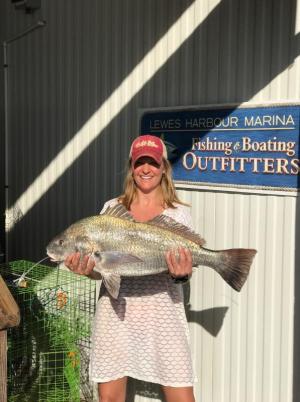On Tuesday, I fished for blue catfish in Broad Creek by the railroad bridge in Laurel. I had some fresh bunker and some salted herring, baits that I heard were tops on a blue catfish’s diet.
I arrived around 9 a.m. and departed around 3 p.m. My first bite came at 1 p.m. At first I thought it was a small catfish. Turned out it was a pickerel. I kept getting bites and caught another pickerel, then the action, such as it was, shut down again.
When I stopped at Taylored Tackle in Seaford to pick up bait, Jerry Taylor said the current state record catfish wouldn’t last. He may be right, but it appears to be safe from me.
Surf action
While I was soaking bait in Laurel, Lisa Knox was soaking bloodworm FishBites at Cape Henlopen State Park. She did a lot better than I.
Lisa brought a 31-inch black drum to Lewes Harbour Marina, where I am sure Tony had a good time removing its suit of armor. She also had a keeper-sized rockfish that spit the hook in the wash, and another big fish that ran off and was never seen.
Lisa should be grateful that I decided to fish on the other side of the state instead of from the beach. As we all know, I can shut off a bite just by showing up, as I did in Laurel.
Sinking the Tamaroa/Zuni
If you read the book or saw the movie “A Perfect Storm,” you may remember the Coast Guard cutter that saved the survivors from the helicopter crash. That ship, the Tamaroa, will be sunk on the Del-Jersey-Land Reef in the near future.
Jeff Tinsman, DNREC Division of Fish and Wildlife reef program coordinator, says the ship has been prepared for sinking by removing all hazardous material and has passed inspection by the EPA and the Coast Guard. Jeff is currently waiting for a weather window of 48 to 72 hours so the ship can be towed to the reef site and sunk. Right now, it looks like the sinking will take place sometime after Easter.
Delaware is the lead agency in this project, suppling 75 percent of the cost through the Federal Aid in Sport Fish Restoration program that matches 3-to-1 the contributions from our General Fishing License Fund. New Jersey will use a 25 percent matching fund from the Fisherman Magazine’s Sportfishing Fund.
Cobia regulations
We are seeing more cobia along the Delaware coast, and this year, for the first time, they have been included in the Delaware Sportfishing Tournament. Anyone catching a cobia weighing more than 45 pounds or releasing one that measures more than 48 inches is eligible for a tournament award.
Sounds simple, right? Ah, but the National Marine Fisheries Service has closed recreational fishing for cobia in federal waters over three miles from shore. This makes it a federal offense to possess a cobia more than three miles from shore.
I spoke with John Clark, director of fisheries at the Division of Fish and Wildlife, about regulations for cobia in Delaware. He said the Atlantic States Marine Fisheries Commission is working on a management plan for cobia in state waters. Currently, Virginia and North Carolina have developed regulations for their waters, and other states are working in that direction. For the foreseeable future, Delaware will not have any regulations on cobia. Just don’t get caught with one in federal waters.
Fishing reports
Back in the days of my misspent youth, I would spend at least a part of my Easter vacation fishing for shad and herring at the spillway in Laurel. Using double shad dart rigs, I would catch herring two at a time and the occasional American shad. Both of these fish are currently on the no-no list and may not be possessed.
This Easter, it will be more about flounder and rockfish, and perhaps a few black drum.
The best rockfish bite has been just south of the C&D Canal. The Yellow Can, the Pipes and the beach at Augustine saw keepers caught last weekend. Bunker and bloodworms have been the best baits. These fish are moving south and could be at the power plant by Easter Sunday
A few flounder have been caught at the Route 90 Bridge in Ocean City, Md., by folks trolling bucktails for rockfish. I have no reports of keepers taken anywhere in Delaware, but this could change overnight. The water is now well into the 50-degree range, so something is bound to happen soon.
Tog have been taken from the ocean when the seas allow boats to leave the dock. While reef sites 10 and 11 have been mentioned, I suspect the better catches have been made by captains who have a little black book full of numbers.




















































